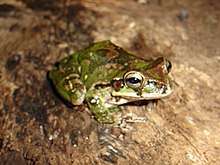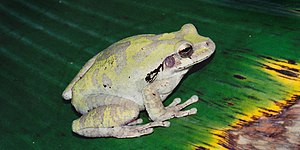Common Mexican tree frog
The common Mexican tree frog (Smilisca baudinii) is a nocturnal species of tree frog whose native range extends from the Sonoran Desert and the Lower Rio Grande Valley of Texas[2] south to Costa Rica. Common names include Mexican tree frog, Baudin's tree frog and Van Vliet's frog. They are usually found within lightly forested areas near permanent sources of water.
| Common Mexican tree frog | |
|---|---|
 | |
| Scientific classification | |
| Kingdom: | Animalia |
| Phylum: | Chordata |
| Class: | Amphibia |
| Order: | Anura |
| Family: | Hylidae |
| Genus: | Smilisca |
| Species: | S. baudinii |
| Binomial name | |
| Smilisca baudinii | |
| Synonyms | |
|
Hyla baudinii | |
Description


The common Mexican tree frog is generally brown-grey in color, with darker brown, irregular blotching. Its underside is typically a lighter grey or white. Its legs have distinctive dark banding.
Taxonomy
The species has numerous synonymous classifications due to disjunct populations, and was mistakenly redescribed on several occasions by field researchers.
Conservation
The common Mexican tree frog is considered to be a threatened species in the US state of Texas.[3] It has only been reported in a few counties, and no estimates of its actual population count have been made.
References
- Santos-Barrera; et al. (2004). "Smilisca baudinii". IUCN Red List of Threatened Species. 2004. Retrieved 12 May 2006.CS1 maint: ref=harv (link) Database entry includes a range map and justification for why this species is of least concern
- "Smilisca baudinii Mexican Treefrog". Herps of Texas. University of Texas at Austin. Retrieved 2010-04-27.
- "Mexican Treefrog (Smilisca baudinii)". Wildlife Fact Sheets. Texas Parks and Wildlife Department. Retrieved 2010-04-27.
External links


